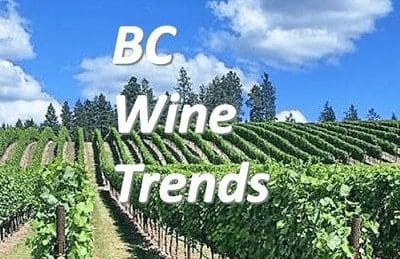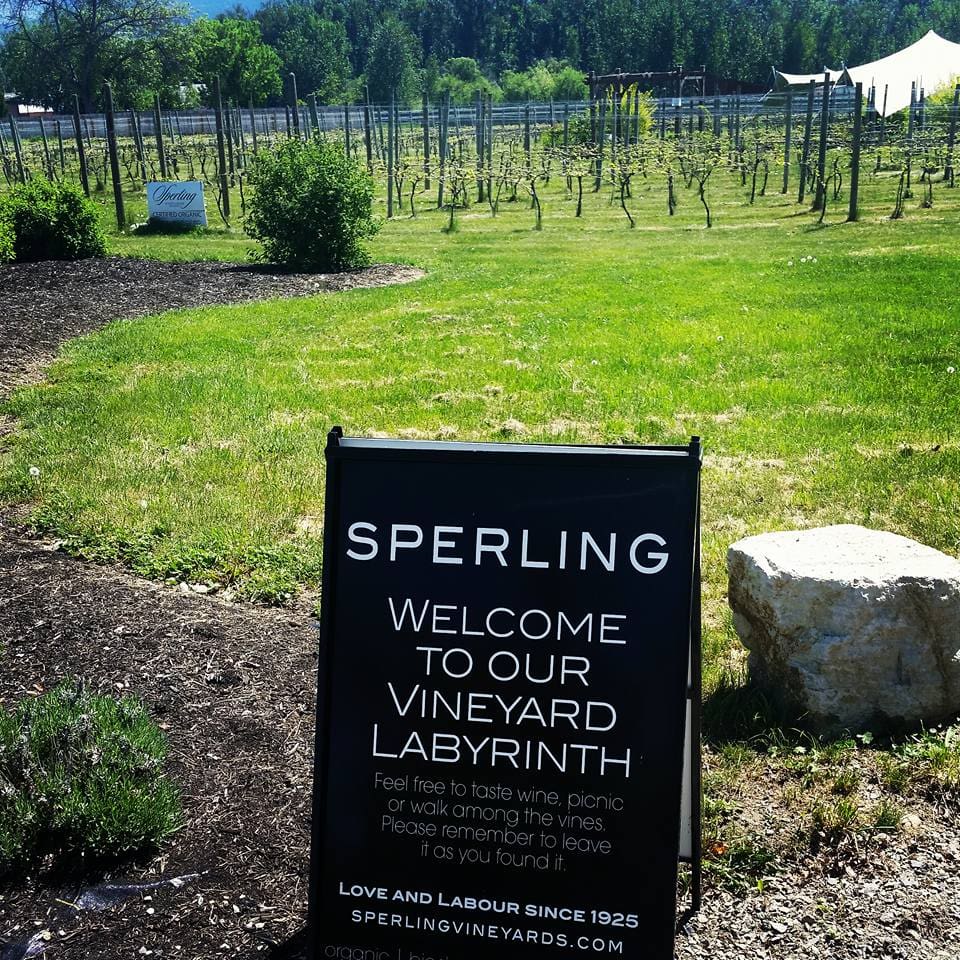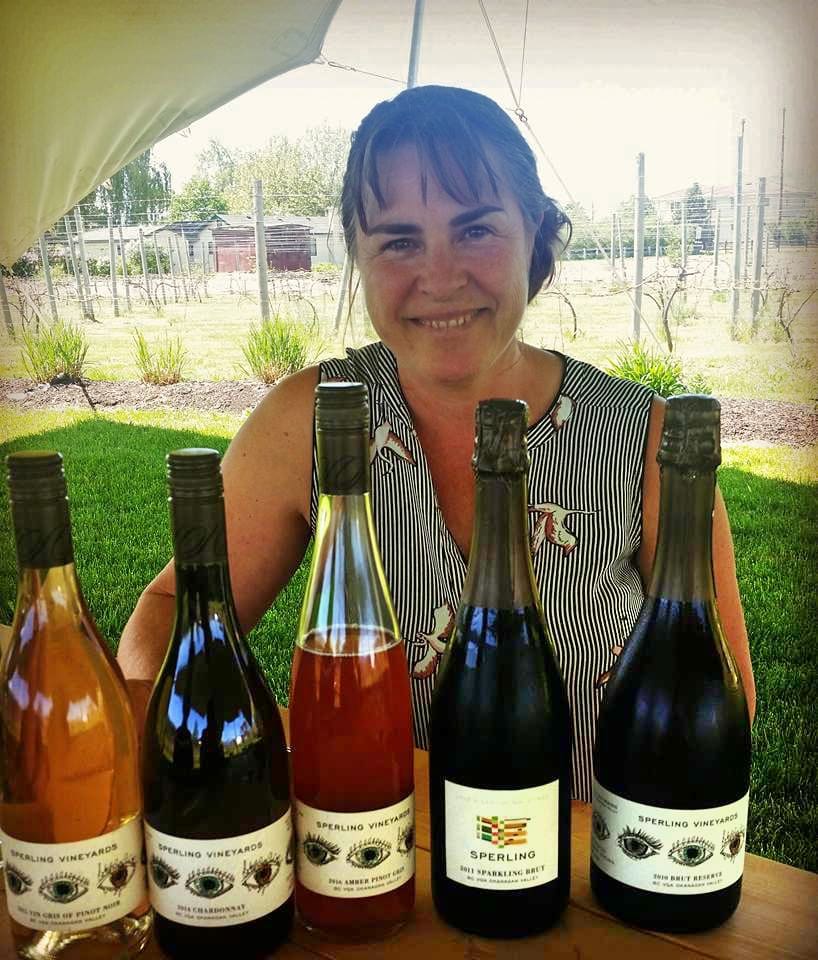Ann Sperling hosted a private wine tasting for us on Mother’s Day under the new tent that is centred in the new Sperling Vineyards Labyrinth. Ann had just returned from managing her other wine properties in Argentina and Ontario. It is always refreshing to talk to a global winemaker about trends in the industry, such as the drive for natural and organic certified wines.
We had the opportunity to chat about the family history of the Sperling Vineyards, the new additions to the property and to taste some of her unique BC wines.
The Vineyard Labyrinth
The vineyard labyrinth has a garden feel about it with the licensed winetasting tent at the core. The tent is perfect for a hot summer day as it traps the coolness from the earth. The vines are planted in a circle so you can take a glass of wine from the tent and wander through the rows of grapes at a relaxing pace.
The Labyrinth should not be compared with a maze that can cause “confusion and anxiety”. Yes, I remember well chasing the grandkids through the local Corn Maze!
 Each row ends at the entranceway so you can do one loop or multiple loops. Vidal vines are planted in the Labyrinth which bud out late as the land is susceptible to late frost. The grapes are later harvested for ice wine. Most vineyards are planted in rows but here the circle format will lead to diversity which complements Ann’s biodynamic winemaking.
Each row ends at the entranceway so you can do one loop or multiple loops. Vidal vines are planted in the Labyrinth which bud out late as the land is susceptible to late frost. The grapes are later harvested for ice wine. Most vineyards are planted in rows but here the circle format will lead to diversity which complements Ann’s biodynamic winemaking.
Sperling Vineyards has been four generations in the making from clearing the land in 1860 to Organic Certification in 2017.
The Winetasting
Sperling Vineyards Brut Reserve 2010
This was a super cool vintage and the first vintage from vines planted in 2008. The dominant soil feature is deep, mineralogical clay with properties of ultrafine limestone particles high in calcium, high in minerals and low to moderate in nitrogen.
80% Pinot Noir and 20% Chardonnay made in the classical method with only 2.5 gms of residual sugar. This wine has a bready aroma from contact with the lees for the 36-month. Citrus, pear and green apple flavours with a hint of biscuit. Fruity and elegant the finish is crisp and dry from this perfectly balanced food-friendly sparkler. Ann has chosen to do vintage dating so you can go back to explore the contribution from the vineyard for a particular vintage, like the Grower Champagne model.
Sperling Vineyards Amber Pinot Gris 2016
Ann commented that “when the wine is opened in the tasting room it can be sampled over a week, the wine changes but doesn’t fall apart! The tannins keep the wine vital. One of the things that annoys wine writers is that the wine changes over time! This just shows how much life there is in the wine.”
Sperling Vineyards Vin Gris of Pinot Noir 2015
Technical Information: Alcohol: 12.0% pH: 3.15 Residual Sugar: 1.34 Total Acidity: 5.9 g/L
Select blocks were hand harvested on a cool September morning at 13% potential alcohol, cluster sorted, then gently whole cluster pressed. Slightly settled juice was transferred to 500 L French oak puncheons to wild ferment to a complete native malolactic fermentation. Each barrel is a unique ferment with individual properties lending complexity to the wine. Select barrels were blended and bottled after 10-12 months of ageing on lees. Some Batonage was employed, but generally not a great deal.
The wine has a bronze hue. Lighter, soft berry and stone fruit flavours with delicate florals and fresh acidity.
Sperling Vineyards Chardonnay 2014
This is a Chablis style Chardonnay. Select blocks were hand harvested, cluster sorted, then gently whole cluster pressed. Slightly settled juice is transferred to 500 L French oak puncheons to wild ferment and complete a native malolactic fermentation. Each barrel becomes a unique ferment with individual properties lending complexity to the wine. Select barrels are blended and bottled after 10-12 months of ageing on lees.
The wine has aromas of citrus with a toasty note from lees ageing. On the palate, there are flavours of peach and apple with a subtle oak expression.
Please visit the Sperling Vineyards website to order these exceptional BC Wines.
Reference:
- There’s a fourth wine colour, and it’s all the rage. Beppi Crosariol, Globe and Mail




These wines sound very interesting, and I like the idea of strolling through the vineyards with a glass of the amber Pinot Gris in hand. A nice way to welcome spring!
The weather has been great, low 90s for the last week. Vines should be shooting soon.